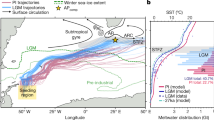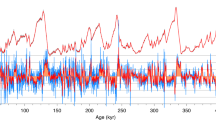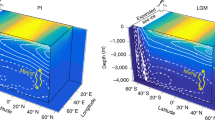Abstract
DEEP water in the world's oceans flows predominantly from the northern North Atlantic into the Pacific1, slowly upwells on the way to become part of the upper warm-water circulation, and returns to the North Atlantic. The stability of this thermohaline conveyor belt has recently been questioned on the basis of palaeoclimatic data from deep-sea sediment and ice cores2,3. Different modes of deep circulation have been confirmed in numeri-cal ocean models4–6, and the present-day circulation has been shown to be sensitive to changes in the surface-water budget7. Here we use an idealized model4,5 to examine the hypothesis that small changes in the atmospheric flux of fresh water from the Atlantic to the Pacific could force the thermohaline circulation to switch between two stable modes. Our results indicate that a decrease of this flux can reverse the Atlantic circulation, although the Pacific thermohaline circulation does not change direction. This is consistent with reconstructions of conditions in the Atlantic Ocean during the last glacial obtained from deep-sea cores8. To reestablish the conveyor belt, the fresh-water flux need be increased only slightly beyond its present value.
This is a preview of subscription content, access via your institution
Access options
Subscribe to this journal
Receive 51 print issues and online access
$199.00 per year
only $3.90 per issue
Buy this article
- Purchase on Springer Link
- Instant access to full article PDF
Prices may be subject to local taxes which are calculated during checkout
Similar content being viewed by others
References
Gordon, A. L. J. geophys. Res. 91, 5037–5046 (1986).
Broecker, W. S. & Denton, G. H. Geochim. cosmochim. Acta 53, 2465–2501 (1989).
Broecker, W. S., Peteet, D. M. & Rind, D. Nature 315, 21–26 (1985).
Wright, D. G. & Stocker, T. F. J. phys. Oceanogr. (in the press).
Stocker, T. F. & Wright, D. G. J. phys. Oceanogr. (in the press).
Marotzke, J. & Willebrand, J. J. phys. Oceanogr. (in the press).
Maier-Reimer, E. & Mikolajewicz, U. in Oceanography (eds Ayala-Castan̄ares, A. et al.) 87–100 (UNAM Press, Mexico, 1989).
Boyle, E. A. & Keigwin, L. Nature 330, 35–40 (1987).
Berger, A. Rev. Geophys. 26, 624–657 (1988).
Duplessy, J. C. et al. Paleoceanography 3, 343–360 (1988).
Labeyrie, L. D., Duplessy, J. C. & Blanc, P. L. Nature 327, 477–482 (1987).
Stommel, H. Tellus 13, 224–230 (1961).
Baumgartner, A. & Reichel, E., The World Water Balance (Elsevier, Amsterdam, 1975).
Miller, J. R., Russell, G. L. Paleoceanography 5, 397–407 (1990).
Marotzke, J., in Ocean Circulation Models: Combining Data and Dynamics (eds Anderson, D. L T. & Willebrand, J.) 501–511 (Kluwer, Dordrecht, 1988).
Levitus, S. Climatological Atlas of the World Ocean (NOAA Prof. Pap. 13, 1982).
Zaucker, F. & Broecker, W. S. J. geophys. Res. (in the press).
Author information
Authors and Affiliations
Rights and permissions
About this article
Cite this article
Stocker, T., Wright, D. Rapid transitions of the ocean's deep circulation induced by changes in surface water fluxes. Nature 351, 729–732 (1991). https://doi.org/10.1038/351729a0
Received:
Accepted:
Issue Date:
DOI: https://doi.org/10.1038/351729a0
This article is cited by
-
Dichotomy between freshwater and heat flux effects on oceanic conveyor belt stability and global climate
Communications Earth & Environment (2023)
-
Preventing a global transition to thermoacoustic instability by targeting local dynamics
Scientific Reports (2022)
-
Observation-based early-warning signals for a collapse of the Atlantic Meridional Overturning Circulation
Nature Climate Change (2021)
-
Overshooting tipping point thresholds in a changing climate
Nature (2021)
-
Multiple drivers of the North Atlantic warming hole
Nature Climate Change (2020)
Comments
By submitting a comment you agree to abide by our Terms and Community Guidelines. If you find something abusive or that does not comply with our terms or guidelines please flag it as inappropriate.



